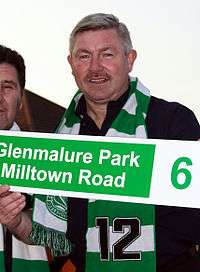Pat Byrne
 | |||
| Personal information | |||
|---|---|---|---|
| Full name | Patrick Joseph Byrne | ||
| Date of birth | 15 May 1956 | ||
| Place of birth | Dublin, Republic of Ireland | ||
| Height | 1.74 m (5 ft 9 in) | ||
| Playing position | Midfielder | ||
| Youth career | |||
| -1974 | Rangers | ||
| Senior career* | |||
| Years | Team | Apps | (Gls) |
| 1974–1978 | Bohemian F.C. | 98 | (20) |
| 1978 | Philadelphia Fury | 19 | (3) |
| 1978–1979 | Shelbourne F.C. | ? | (0) |
| 1979–1981 | Leicester City | 36 | (3) |
| 1981–1983 | Heart of Midlothian F.C. | 65 | (11) |
| 1983–1988 | Shamrock Rovers F.C. | 126 | (16) |
| 1988–1993 | Shelbourne F.C. | ? | (?) |
| 1993–1994 | Cobh Ramblers | 4 | (0) |
| 1993–1994 | St James's Gate F.C. | 0 | (0) |
| 1993–1994 | Shelbourne F.C. | 1 | (0) |
| National team | |||
| 1974–1987 | League of Ireland XI | ? | (1) |
| 1984–1986 | Republic of Ireland | 8 | (0) |
| Teams managed | |||
| 1988–1993 | Shelbourne F.C. | ||
| 1995–1996 | St James's Gate F.C. | ||
| 1996–1997 | Shamrock Rovers | ||
| 1999–2000 | Kilkenny City F.C. | ||
|
* Senior club appearances and goals counted for the domestic league only. | |||
Pat Byrne (born 15 May 1956, in Dublin) is a former Irish football player and manager.
Playing career
A central midfielder, Byrne's playing career started with Bohemians, his debut coming against St Patricks Athletic on 25 August 1974 in a LFA President's Cup Final. He made 162 appearances in all competitions for Bohs (98 in the league, 10 in European competition)[1] and won 2 League of Ireland titles and 1 FAI Cup before he moved to the USA in 1978, for a year with the Philadelphia Fury of the North American Soccer League where he played alongside fellow Irishmen Fran O'Brien (footballer) and Eddie Byrne (footballer). He played in eighteen matches plus one play-off game and scored three goals.[2] Pat's team mates included Alan Ball, Peter Osgood and Johnny Giles. He played against the likes of Rodney Marsh, Carlos Alberto, Franz Beckenbauer, Giorgio Chinaglia and Bobby Moore.
He returned to Europe in 1979, playing for Leicester City until 1981, then Heart of Midlothian until 1983.[3] While playing for the Tynecastle side he was based in Dublin, and would regularly commute for weekend fixtures. When this became too much of a burden, he was granted a free transfer and joined League of Ireland side Shamrock Rovers.
In April 1983 he played for the League of Ireland XI U21s against their Italian League counterparts who included Roberto Mancini and Gianluca Vialli in their team .
At Glenmalure Park, he had extraordinary success winning 4 league titles in a row and the FAI Cup 3 times between 1984 and 1987. He was the clubs Player of the Year in 1984/85 and also picked up the SWAI Personality of the Year award for that season. During this time he also won 8 full international caps, 3 Inter League caps scoring once and played in 2 1988 Summer Olympics qualifiers. He made 7 appearances for Rovers in European competition.
Management career
His distinguished career in the green and white came to an end at the end of the 1987/88 season when he was installed as player-manager of Shelbourne F.C. in 1988.[4] By 1992, he had guided Shels to their first League of Ireland title in thirty years and the following year, he guided them to their first FAI Cup success in thirty years, when they beat Dundalk 1–0 in the cup final at Lansdowne Road. In the Cup Winners' Cup that autumn, Byrne brought Shels their first European victory since 1964 when they knocked out Ukrainian side Karpaty Lviv 3–2 on aggregate. Byrne was sacked along with his assistant Jim McLaughlin shortly afterwards,[5] and was succeeded by Eoin Hand.
Pat became player/manager of St James's Gate F.C. in February 1994 before he came back to Rovers to manage the club for the 1996/1997 season. He later managed Kilkenny City to promotion to the Premier Division.
In September 2006, he became an official Shamrock Rovers Legend.[6]
Honours
As a player
 League of Ireland: 6
League of Ireland: 6
- FAI Cup: 4
- Bohemians 1976
- Shamrock Rovers 1985, 1986, 1987
- League of Ireland Cup: 1
- Bohemians 1975
- Leinster Senior Cup: 3
- Bohemians 1974/75, 1975/76
- Shamrock Rovers 1984/85
- LFA President's Cup: 2
- Bohemians 1974/75
- Shamrock Rovers 1984/85
- Football League Second Division[7]
- Leicester City F.C. 1979/80
- PFAI Player of the Year: 1
- Shamrock Rovers – 1983/84
- SWAI Personality of the Year: 1
- Shamrock Rovers – 1984/85
- SRFC Player of the Year: 1
- Shamrock Rovers – 1984/85
As a manager
- League of Ireland: 1
- Shelbourne F.C. 1992
- FAI Cup: 1
- Shelbourne F.C. 1993
- SWAI Personality of the Year
- Shelbourne F.C. – 1991/92
References
- ↑ Bohemian FC match programme, Vol. 46, no. 5
- ↑
- ↑
- ↑
- ↑
- ↑ "Archived copy". Archived from the original on 13 July 2007. Retrieved 4 February 2009.
- ↑ From 1992 the second tier of English football was known as Football League First Division. Since 2004 it has been known as the Football League Championship.
- Sources
- The Hoops by Paul Doolan and Robert Goggins (ISBN 0-7171-2121-6)